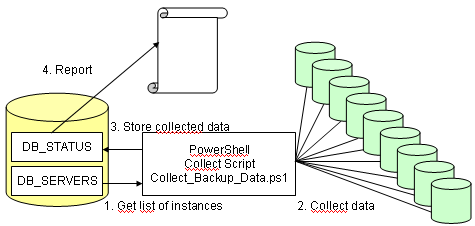 In my previous post I’ve shown how to collect data and insert it into a database table using PowerShell. Now it’s time to get some information from that data, and I’ve used TSQL for this purpose.
In my previous post I’ve shown how to collect data and insert it into a database table using PowerShell. Now it’s time to get some information from that data, and I’ve used TSQL for this purpose.
The backup exceptions
Every environment has some backup rules and backup exceptions. For example, you don’t want to check for failures on the model, northwind, adventureworks or distribution databases.
I’ve got the rid of this problem by using the “exception table” created in the previous post. The rules are defined by pattern matching. First we need to define a generic rule for our default backup schedules:
|
1 2 3 4 5 6 |
INSERT INTO [Tools].[dbo].[DB_Backup_Exceptions] ([InstanceName],[DatabaseName],[LastFullHours] ,[LastLogHours],[Description],[BestBefore]) VALUES ('%','%',36,12,'Default delays for all databases',NULL) GO |
In the previous example, we’ll check that all databases (‘%’) on all instances (again ‘%’) have been backed up at least every 36 hours, and a backup log have occurred in the last 12 hours. The description is useful to remember why such rule exists.
The “BestBefore” column allows to define the time limit of the rule. For example, if you do some maintenance and you are skipping some schedules, you can safely insert a rule that expires after X days, so you can avoid some alerts while avoiding also to forget to delete the rule.
|
1 2 3 4 5 6 |
INSERT INTO [Tools].[dbo].[DB_Backup_Exceptions] ([InstanceName],[DatabaseName],[LastFullHours] ,[LastLogHours],[Description],[BestBefore]) VALUES ('SERVER1','%',1000000,1000000,'Maintenance until 012.05.2013', '2013-05-12 00:00:00') GO |
The previous rule will skip backup reports on SERVER1 until May 12th.
|
1 2 3 4 5 6 |
INSERT INTO [Tools].[dbo].[DB_Backup_Exceptions] ([InstanceName],[DatabaseName],[LastFullHours] ,[LastLogHours],[Description],[BestBefore]) VALUES ('%','Northwind',1000000,1000000,'Don''t care about northwind',NULL) GO |
The previous rule will skip all reports on all Northwind databases.
Important: If multiple rules apply to the same database, the rule with a higher time threshold wins.
The queries
The following query lists the databases with the last backup full older than the defined threshold:
|
1 2 3 4 5 6 7 8 9 10 11 |
select s.InstanceName, s.DatabaseName, s.LastFull, floor(convert(float,GETDATE()-LastFull)*24) as LastFullAge from db_status s, DB_Backup_Exceptions e where s.InstanceName like e.InstanceName and s.DatabaseName like e.DatabaseName and (e.bestbefore is null or e.bestbefore > GETDATE()) and s.DatabaseStatus!='OFFLINE' group by s.InstanceName, s.DatabaseName, s.LastFull having LastFull < GETDATE()-(max(e.LastFullHours)/24.0) order by s.InstanceName, s.DatabaseName GO |
And the following will do the same for the transaction logs:
|
1 2 3 4 5 6 7 8 9 10 11 |
select s.InstanceName, s.DatabaseName, s.LastLog, floor(convert(float,GETDATE()-LastLog)*24) as LastLogAge from db_status s, DB_Backup_Exceptions e where s.InstanceName like e.InstanceName and s.DatabaseName like e.DatabaseName and (e.bestbefore is null or e.bestbefore > GETDATE()) and s.DatabaseStatus!='OFFLINE' and s.RecoveryMode='FULL' group by s.InstanceName, s.DatabaseName, s.LastLog having LastLog < GETDATE()-(max(e.LastLogHours)/24.0) order by s.InstanceName, s.DatabaseName GO |
Putting all together
Copy and paste the following to a new Transact-SQL job step in SQLAgent:
|
1 2 3 4 5 6 7 8 9 10 11 12 13 14 15 16 17 18 19 20 21 22 23 24 25 26 27 28 29 30 31 32 33 34 35 36 37 38 39 40 41 42 43 44 45 46 47 48 49 50 51 52 53 54 55 56 57 58 59 60 61 62 63 64 65 66 67 68 69 70 71 72 73 74 75 76 77 78 79 80 81 82 83 84 85 86 87 88 89 90 91 92 93 94 95 96 97 98 99 100 |
declare @tableHTML varchar(max), @Email varchar(255), @Subject varchar(255); SET @Email = 'your_mail@yourdomain.com' SET @Subject = 'Report backup SQL Server' /* ###################### # REPORT BACKUP FULL # ###################### */ set @tableHTML = N'<html><body><h1>Backup full not completed within the defined threshold</h1> <table border="1" width="100%"> <tr><b><th>Instance</th><th>Database</th><th>LastFull</th><th>Hours since Last Full</th></tr> ' set @tableHTML = @tableHTML + isnull(CAST(( select td = s.InstanceName, '', td = s.DatabaseName, '', td = s.LastFull, '', td = floor(convert(int,convert(float,GETDATE()-LastFull)*24,0)), ' ' from db_status s, DB_Backup_Exceptions e where s.InstanceName like e.InstanceName and s.DatabaseName like e.DatabaseName and (e.bestbefore is null or e.bestbefore > GETDATE()) and s.DatabaseStatus!='OFFLINE' group by s.InstanceName, s.DatabaseName, s.LastFull having LastFull < (GETDATE()-max(e.LastFullHours)/24.0) order by s.InstanceName, s.DatabaseName for XML path ('tr'), TYPE) AS NVARCHAR(MAX)),''); /* ###################### # REPORT BACKUP LOG # ###################### */ SET @tableHTML = @tableHTML + N' </table> <BR/><BR/> <h1>Backup log not completed within the defined threshold</h1> <table border="1" width="100%"> <tr><b><th>Instance</th><th>Database</th><th>LastLog</th><th>Hours since Last Log</th></tr> '; set @tableHTML = @tableHTML + isnull(CAST(( select td = s.InstanceName, '', td = s.DatabaseName, '', td = s.LastLog, '', td = floor(convert(int,convert(float,GETDATE()-LastLog)*24,0)), ' ' from db_status s, DB_Backup_Exceptions e where s.InstanceName like e.InstanceName and s.DatabaseName like e.DatabaseName and (e.bestbefore is null or e.bestbefore > GETDATE()) and s.DatabaseStatus!='OFFLINE' and s.RecoveryMode='FULL' group by s.InstanceName, s.DatabaseName, s.LastLog having LastLog < (GETDATE()-max(e.LastLogHours)/24.0) order by s.InstanceName, s.DatabaseName for XML path ('tr'), TYPE) AS NVARCHAR(MAX)),''); /* ################### # LIST EXEPTIONS # ################### */ SET @tableHTML = @tableHTML + N' </table> <BR/><BR/> <h1>List of exceptions currently defined</h1> <table border="1" width="100%"> <tr><b><th>Instance</th><th>Database</th><th>LastFullHours</th><th>LastLogHours</th><th>Description</th><th>BestBefore</th></tr> '; set @tableHTML = @tableHTML + CAST(( select td = InstanceName, '', td = DatabaseName, '', td = LastFullHours, '', td = LastLogHours, '', td = Description, '', td = ISNULL(convert(varchar,bestbefore,127), 'never'), '' from DB_Backup_Exceptions where (bestbefore is null or bestbefore > GETDATE()) order by InstanceName, DatabaseName for XML path ('tr'), TYPE) AS NVARCHAR(MAX)); SET @tableHTML = @tableHTML + N' </table> <br/><br/> <font size="3">Information message. Please do not reply to this email.</h1></body></html>'; EXEC msdb.dbo.sp_send_dbmail @recipients = @Email, @subject = @Subject, @body = @tableHTML, @body_format = 'HTML', @profile_name = 'DBA' |
Any comment appreciated!
Previous: SQLServer centralized backup monitoring with PowerShell and TSQL (1/2)
🙂
—
Ludovico


